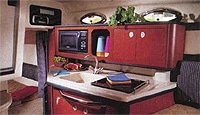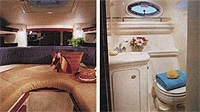
Sea Ray 260 Sundancer

Sea Ray 260 Sundancer
Try installing test gear on a trailerable cruiser-go on, I dare ya. It’s not just that the niceties of a 35-footer-water heater, waste tank, vacuum generator for the head, and so on-are all crammed into 2′ less beam, forcing blind, one-handed wrenching of fittings. What’s more distressing is that once the engine hatch is up, that is to say, the entire cockpit sole, there’s no way to get off the boat without closing the hatch. If I need a tool or tiewrap, I have to climb out of the engine space, close the hatch, and retrieve what I need from the toolbox on the swim platform.
Chances are, you won’t install fuel flow equipment on your boat, but you will service filters, batteries, and bilge switches. The process-and the problem-is the same.
Sea Ray solved this dilemma by redesigning the swim platform aboard its new 260 Sundancer. Because the platform is now integral to the deck, the engine hatch can be larger. In fact, it extends out onto the platform. Plus, the swim ladder is mounted underneath the platform. Without the ladder hatch, the engine hatch can protrude even farther onto the platform. Finally, the hatch is offset to starboard, leaving a strip of sole as a walkway between the helm and the boarding door.
Designing a boat that makes maintenance easier is just one thing I like about the 260 Sundancer. It’s one of the best-and most expensive-pocket cruisers you can buy.
PEARL JAM. But don’t dismiss the 260 Sundancer for its high price. I’ve tested less expensive boats that don’t deliver the goods, despite their lower price. The goods here can be seen again in the engine compartment.
Besides its easy-come-easy-go access, you’ll find a gasket sealing the hatch into its deep gutter. Gaskets are common, you say. Not this one. Instead of a thin strip of open-cell foam that soaks up water and compresses itself into worthlessness after a season, the one installed on the 260 Sundancer is thick, smooth-surfaced foam that resists absorption and retains its shape. It thus keeps water out and engine noise in.
Now check the gleaming white-Sea Ray calls it pearl-gel coat inside the engine compartment. It brightens the space, so a dropped tool or a leak is easy to spot. But the reason for the gel coat is more important than its aesthetics. Note that the 260 Sundancer’s backbone consists of a single fiberglass stringer grid, instead of a lattice of separate stringers and bulkheads. It’s a complete liner, set in adhesive inside the hull while the hull is still in its mold. This incorporates the longitudinal supports and the engine beds, tank compartments, and even platforms for mounting such accessories as batteries. So in addition to providing better visibility, this strengthens the boat, provides a firm foundation for the motor, and eases serviceability by placing accessories on level and robust surfaces where they are easy to get at.
Run the 260 Sundancer, and this construction method proves its merit. It planes quickly, maintains plane at just 11.3 mph, boasts spirited handling in the 3500-to-4500-rpm range-typical for boats of this type. What’s not typical is that it arcs stiffly through turns and seems more in sync with helm input than other boats I’ve tested. I attribute the fiberglass stringer grid with its full-height, full-beam support for this elusive but valuable attribute.
On deck, you’ll find equally secure mounting of rail stanchions, cleats, and the ski-tow-eye flush-mounted on the transom. I’m talking about more than just the nuts, bolts, and backing plates. All fixtures sit on a flat that’s been molded into the deck. I’ve often seen deck hardware with fasteners that have been torqued almost to the breaking point to get the fixture’s body to conform to the curved surface of the boat. This stresses the fixture and the fastener, and it doesn’t allow for a long-term watertight seal. The mounting flats, stringer grid, and even the clean, grippy, diamond nonslip exist by virtue of the precision provided by the five-axis routers used in the manufacture of the boat. You won’t see this on boats produced from plugs and molds that are hand built.
SOCIAL PLEASURES. These things create enough confidence in the 260 Sundancer’s long-term durability to put a smile on any skipper’s face. To get your crew grinning, check out the accommodations. A section of the cockpit lounge converts to a sunpad simply by pulling it out-no cushion to store. Remove another section to reveal a cockpit step, so boarding from the side is easy. The gunwale tops are covered with nonslip for the same reason. The wetbar features a sink, stowage, a cooler, and a grabrail that a sumo wrestler couldn’t budge. But I’d rather see this rail mounted along the counter edge instead of below it, so it could serve double duty as a grabrail and searail, holding people and gear in place.
The helm features more five-axis magic, with flats for electronics molded in. It’s a white helm though, which creates glare. A tan helm, like the one aboard Regal’s 2665 ($79,139 powered like our test boat), is optional on the Sea Ray. Furthermore, the accessory switches are toggles, rather than the multiplexed, waterproof touchpads that were a Sea Ray staple until now. Sea Ray says consumers demanded the change back to toggles. However, toggle switches break too easily. There’s plenty of room between the helm and the companion lounge, which seats three or allows a single passenger to recline against the helm.
The companionway hatch is a slider with wide bow steps molded in. This is superior to the small pedestals other builders put on their helms under the dubious name of steps.
Belowdecks, the 260 Sundancer boasts big-boat style, with a parchment-colored headliner and wood laminate cabinetry with searails. There’s access to the V-berth stowage from the berth base and by lifting the cushions. There’s a butane stove in the galley, or use the microwave while plugged into the shorepower at the dock. The head is molded as a single unit and has a frosted port for privacy and a drain for easy cleanup. But there’s no 110-volt outlet here.
The 12-volt ground wires aboard the 260 Sundancer are black. The ABYC recommends using yellow for 12-volt ground aboard boats that also have 110-volt shorepower installed because black is the color of a “hot” 110 wire. With yellow low-voltage grounds, you’re less likely to confuse a “harmless” wire with one carrying enough current to kill.
The midberth is wide enough for two, features good sitting headroom, and has great ventilation due to the large sliding port. But its 17″-wide entry makes getting in tight. The midberth on Rinker’s Fiesta Vee 250 ($60,129 with a 320-hp MerCruiser MX 6.2 Bravo Three stern drive) is better suited for adult entry. ****
Extra Point: The engine hatch is cored with closed-cell foam. Besides making the hatch stiff and lightweight, this enhances sound retention.
Sea Ray Boats – Knoxville, Tennessee; searay.com









